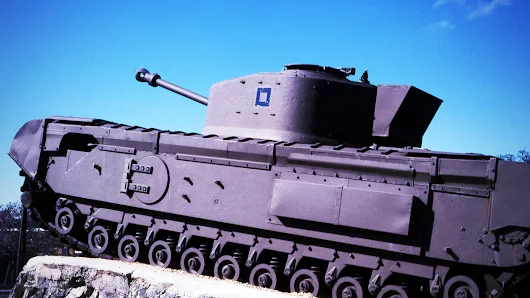The Raid on Dieppe: Dieppe, France, 19 August 1942 .
"The Dieppe Raid, also known as the Battle of Dieppe, Operation Rutter during planning stages, and by its final official code-name Operation Jubilee, was an Allied attack on the German-occupied port of Dieppe during the Second World War. The raid took place on the northern coast of France on 19 August 1942. The assault began at 5:00 a.m., and by 10:50 a.m. the Allied commanders were forced to call a retreat. Over 6,000 infantrymen, predominantly Canadian, were supported by The Calgary Regiment of the 1st Canadian Tank Brigade and a strong force of Royal Navy and smaller Royal Air Force landing contingents. It involved 5,000 Canadians, 1,000 British troops, and 50 United States Army Rangers.
Objectives included seizing and holding a major port for a short period, both to prove that it was possible and to gather intelligence. Upon retreat, the Allies also wanted to destroy coastal defences, port structures and all strategic buildings. The raid had the added objectives of boosting morale and demonstrating the firm commitment of the United Kingdom to open a western front in Europe.
Virtually none of these objectives were met. Allied fire support was grossly inadequate and the raiding force was largely trapped on the beach by obstacles and German fire. Less than 10 hours after the first landings, the last Allied troops had all been either killed, evacuated, or left behind to be captured by the Germans. Instead of a demonstration of resolve, the bloody fiasco showed the world that the Allies could not hope to invade France for a long time. Some intelligence successes were achieved, including electronic intelligence.
Of the 6,086 men who made it ashore, 3,623 (almost 60%) were either killed, wounded or captured. The Royal Air Force failed to lure the Luftwaffe into open battle, and lost 106 aircraft (at least 32 to anti-aircraft fire or accidents), compared to 48 lost by the Luftwaffe. The Royal Navy lost 33 landing craft and one destroyer. The events at Dieppe influenced preparations for the North African (Operation Torch) and Normandy landings (Operation Overlord)."
GC+ blunders.
"From conception to execution, the Dieppe raid was filled with unclear objectives and poor planning. Why did the Allies undertake such an ill-fated attack on this German-occupied French city? Find out here, along with a detailed account of what went wrong—from bad timing to overambitious strategies to unexpectedly difficult terrain."
Dieppe 1942 - Slaughter on the Shingle - MaFe > .
*World War Two heroine 'Angel of Dieppe' *
http://www.bbc.com/news/world-us-canada-43844090
42-8-19 Dieppe Raid
The Dieppe Raid, also known as the Battle of Dieppe, Operation Rutter during planning stages, and by its final official code-name Operation Jubilee, was an Allied attack on the German-occupied port of Dieppe during the Second World War. The raid took place on the northern coast of France on 19 August 1942. The assault began at 5:00 a.m., and by 10:50 a.m. the Allied commanders were forced to call a retreat. Over 6,000 infantrymen, predominantly Canadian, were supported by The Calgary Regiment of the 1st Canadian Tank Brigade and a strong force of Royal Navy and smaller Royal Air Force landing contingents. It involved 5,000 Canadians, 1,000 British troops, and 50 United States Army Rangers.
Objectives included seizing and holding a major port for a short period, both to prove that it was possible and to gather intelligence. Upon retreat, the Allies also wanted to destroy coastal defences, port structures and all strategic buildings. The raid had the added objectives of boosting morale and demonstrating the firm commitment of the United Kingdom to open a western front in Europe.
Virtually none of these objectives were met. Allied fire support was grossly inadequate and the raiding force was largely trapped on the beach by obstacles and German fire. Less than 10 hours after the first landings, the last Allied troops had all been either killed, evacuated, or left behind to be captured by the Germans. Instead of a demonstration of resolve, the bloody fiasco showed the world that the Allies could not hope to invade France for a long time. Some intelligence successes were achieved, including electronic intelligence.
Of the 6,086 men who made it ashore, 3,623 (almost 60%) were either killed, wounded or captured. The Royal Air Force failed to lure the Luftwaffe into open battle, and lost 106 aircraft (at least 32 to anti-aircraft fire or accidents), compared to 48 lost by the Luftwaffe. The Royal Navy lost 33 landing craft and one destroyer. The events at Dieppe influenced preparations for the North African (Operation Torch) and Normandy landings (Operation Overlord).
https://en.wikipedia.org/wiki/Dieppe_Raid
"From conception to execution, the Dieppe raid was filled with unclear objectives and poor planning. Why did the Allies undertake such an ill-fated attack on this German-occupied French city? Find out here, along with a detailed account of what went wrong—from bad timing to overambitious strategies to unexpectedly difficult terrain."
Dieppe Raid: Catastrophe on the Beach—1942 | The Great Courses Plus




No comments:
Post a Comment
Note: Only a member of this blog may post a comment.